The VLOOKUP function in Excel is one of the most commonly used and powerful tools for looking up and retrieving data from a table based on a specific search criterion. Whether you're a beginner or have some experience with Excel, this guide will walk you through how to use the VLOOKUP formula in Excel, along with a variety of examples to help you master this function.
In this tutorial, we will explore different VLOOKUP use cases such as finding values in the same sheet, across different sheets, and even across different files with complex filenames. Additionally, we’ll cover some common problems and troubleshooting tips to make your Excel VLOOKUP experience smoother. If you are new to excel follow the Step-by-Step Guide to Data Analysis and Excel: From Basic Formulas to Advanced Analytics.
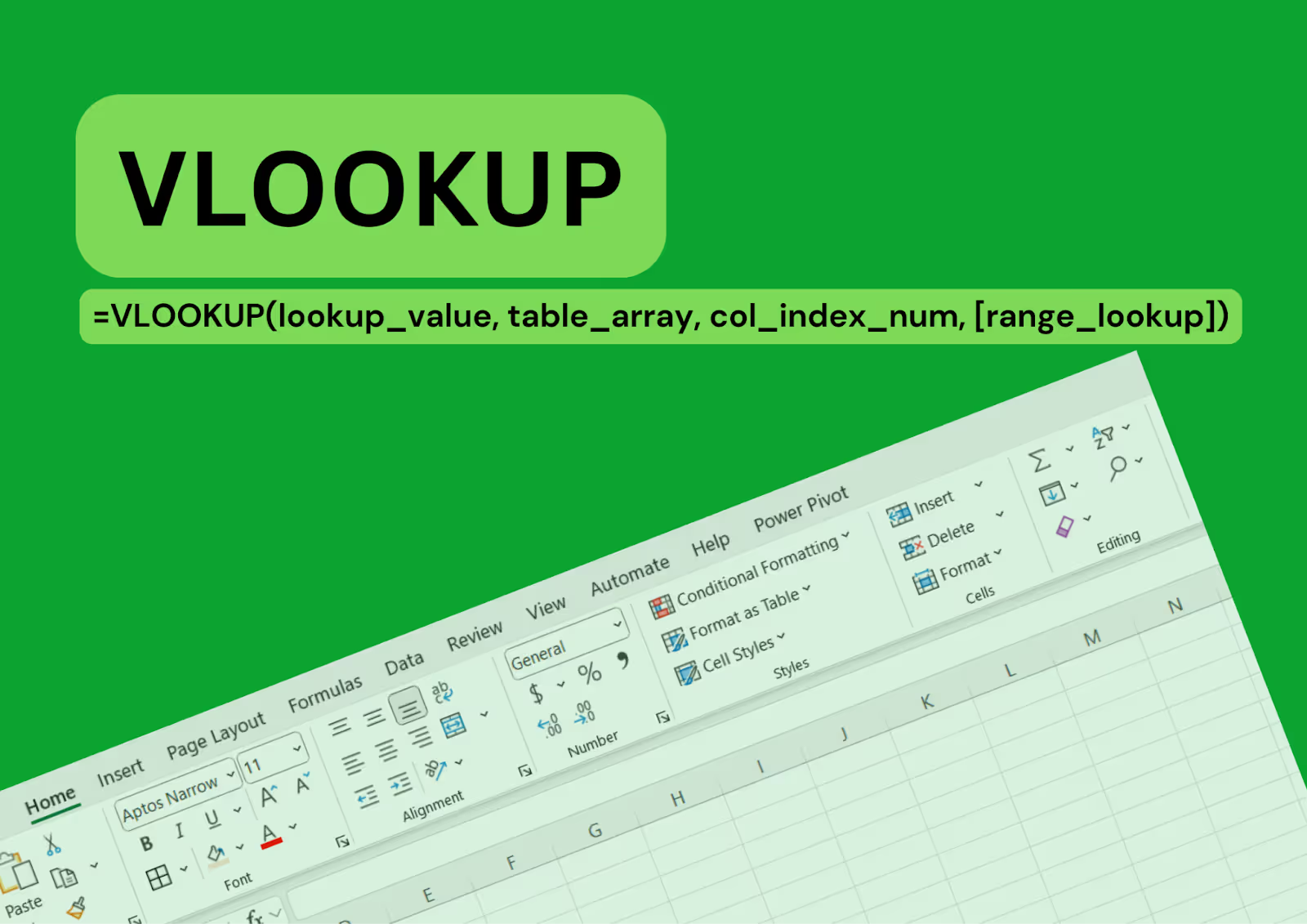
What is VLOOKUP in Excel?
VLOOKUP (short for “Vertical Lookup”) searches for a value in the first column of a specified range and returns a value in the same row from another column. It is designed to search for a value in the first column of a table (a range of cells) and return a value in the same row from another column. It’s commonly used to fetch data like prices, employee details, or product information from structured datasets.
The Syntax of VLOOKUP

- lookup_value: The value you want to search for. It can be a cell reference or a specific value (e.g., 100).
- table_array: The range of cells that contains the data you want to search through. The first column in this range should contain the values you're searching for.
- col_index_num: The column number (starting from 1) in the table_array from which to retrieve the value.
- [range_lookup]: This is optional. If you use TRUE (or leave it blank), Excel will perform an approximate match; if you use FALSE, it will search for an exact match.
Example 1: Basic VLOOKUP in the Same Sheet
Let's start with a basic example where you have a product list with product IDs and prices in the same sheet:
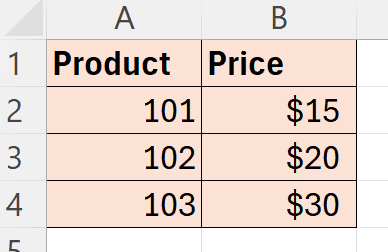
To find the price of product ID 102, the formula will be:

This will return $20, which is the price of product ID 102 in the second column of the range A2:B4.
Example 2: VLOOKUP Across Different Sheets
If your data is spread across different sheets in the same workbook, you can use VLOOKUP to search for a value in one sheet and retrieve data from another sheet.
Assume you have the following data on Sheet1:

And on Sheet2, you have a list of product IDs for which you need to retrieve prices. To search for the price of product 101 from Sheet1, use this formula on Sheet2:

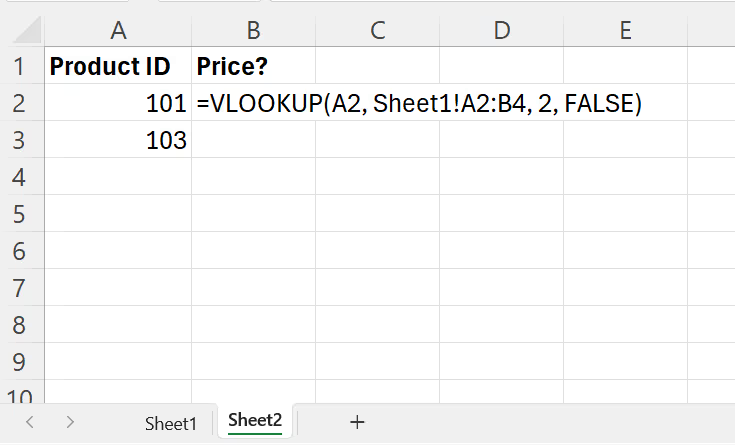
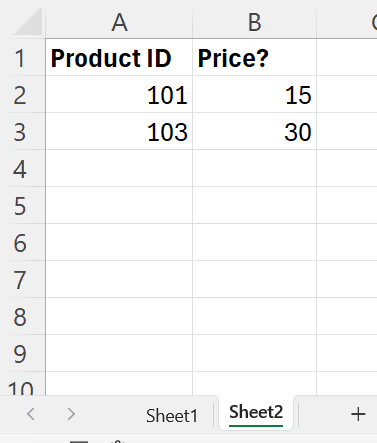
In this formula:
- A2 refers to the product ID you want to look up.
- Sheet1!A2:B4 is the range of data on Sheet1 where you want to search.
- 2 indicates that you want the price from the second column.
Example 3: VLOOKUP Across Different Files
Now, let’s say you have two separate Excel files: File1.xlsx and File2.xlsx. You want to look up data in File2.xlsx while working in File1.xlsx. Here’s how to do it:
- Open both files.
- In File1.xlsx, use the formula referencing the data in File2.xlsx:

This will retrieve the price from File2.xlsx based on the product ID in File1.xlsx.
Note: When referencing data in another file, ensure both files are open. If the files are closed, Excel will still work, but it will include the full file path in the formula.
Also Read: 30 Most Commonly Asked Power BI Interview Questions
Example 4: VLOOKUP with Complex Filenames
In cases where your Excel file has a complex filename or is located in a different directory, you will need to reference the full path in the formula. For example:

This references ProductDataFile.xlsx located in the Documents folder on your C: drive.
Common Problems and Solutions with VLOOKUP
Problem 1: #N/A Error
One of the most common errors when using VLOOKUP is the #N/A error. This typically happens when the lookup value is not found in the first column of the table array. Here’s how to troubleshoot:
Solution:
- Ensure that the lookup value exists in the first column of the table.
- Check if there's an exact match (if you're using FALSE for range_lookup).
- If you're using TRUE for approximate matching, ensure the table is sorted in ascending order.
Problem 2: #REF! Error
The #REF! error usually occurs when you provide an invalid column index number. For example, if you specify a column number greater than the number of columns in the table array.
Solution:
- Double-check the col_index_num to ensure it corresponds to a valid column in your table_array.
Problem 3: Incorrect Results Due to Approximate Match
When using TRUE for range_lookup, the VLOOKUP function finds the closest match rather than an exact match. This can lead to incorrect results if your data isn’t sorted properly.
Solution:
- If you need an exact match, always use FALSE for range_lookup.
Problem Statements and Solutions
Problem 1: Find the Salary of an Employee Using VLOOKUP
Scenario: You have a list of employees and their salaries in Sheet1, and you need to find the salary of a specific employee.
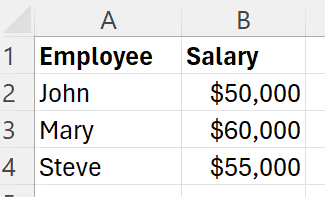
To find Mary’s salary, use the formula:

This will return $60,000, which is Mary’s salary.
Problem 2: Retrieve Product Price Based on ID from Different File
Scenario: You have a list of product IDs and their prices in File2.xlsx, and you need to retrieve the price of a product from File1.xlsx based on the ID.
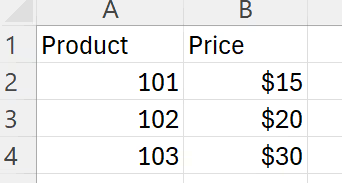
In File1.xlsx, to find the price of product 102, use the formula:

This will return $20.
Problem 3: Handling Errors in VLOOKUP
Scenario: You are looking up a product ID that might not exist in your list. To avoid the #N/A error, you can use the IFERROR function along with VLOOKUP.

If product ID 105 doesn’t exist, this will return "Product Not Found" instead of an error.
Also Read: Web Scraping with Python and Scrapy: Building Your First Project
Pros and Cons of VLOOKUP in Excel
The VLOOKUP function is one of the most widely used tools in Excel due to its simplicity and usefulness. However, like any tool, it comes with its advantages and limitations. Here’s a breakdown of the pros and cons of VLOOKUP to help you understand when and why to use it, and when you might want to consider alternatives.
Pros of VLOOKUP
- Ease of Use
- The VLOOKUP formula is straightforward and easy to learn, making it perfect for beginners. It doesn’t require complex syntax, which makes it quick to implement even for those who are not very experienced with Excel formulas.
- Powerful Lookup Functionality
- VLOOKUP allows you to search for a value in a table and retrieve data from a different column in the same row. This functionality is extremely useful for finding specific information quickly, especially when working with large datasets.
- Handles Exact and Approximate Matches
- VLOOKUP can be used for both exact and approximate matches. By setting the [range_lookup] parameter to FALSE, you can find exact matches, and by setting it to TRUE, you can retrieve the closest match. This flexibility is useful in a variety of situations.
- Versatile Across Sheets and Files
- As seen in the examples, VLOOKUP can be used across multiple sheets within the same workbook or even across different workbooks. This allows you to consolidate data from various sources into a single analysis without the need for manually copying and pasting data.
- Quick Data Retrieval
- It helps automate the process of looking up values, which can save time when you're working with extensive data. Whether you're searching for employee salaries, product prices, or any other piece of information, VLOOKUP can quickly pull the data you need from a table.
Cons of VLOOKUP
- Limited to Leftmost Column
- One of the biggest limitations of VLOOKUP is that it can only search for the lookup value in the leftmost column of the table_array. If the data you're looking for is in a column to the right of your lookup column, you would either need to rearrange your data or use a more flexible alternative like INDEX-MATCH.
- Inflexibility with Column Reordering
- Since VLOOKUP relies on the column index number to determine where to fetch data, if the order of columns changes, the formula will break unless you manually update the column index number. This makes it less flexible compared to other functions like INDEX-MATCH, which doesn’t rely on column positioning.
- Can’t Look Left
- VLOOKUP is a right-to-left lookup, meaning it cannot search for a value in a column to the left of your reference column. For example, if you need to find a value based on information in the right-hand columns, VLOOKUP won’t work, and you'll need to use a more versatile function like INDEX-MATCH.
- Requires Exact Column Indexing
- The col_index_num argument requires that you specify the column number from which to return the value. This can be cumbersome if you are working with a large table with many columns, and it can also lead to errors if columns are added or removed from the dataset.
- Performance Issues with Large Datasets
- VLOOKUP can slow down significantly when applied to large datasets or when used in multiple formulas across a workbook. This is because VLOOKUP has to scan through the entire table_array to find the lookup value, which can lead to performance issues, especially in large Excel files.
- No Exact Match Warning in Some Cases
- When using the TRUE (approximate match) option, if the lookup value is not found, VLOOKUP will return the closest match instead of an exact match, which may not be what you want. This can lead to inaccurate results if the data is not sorted properly.
- Error Handling
- If the VLOOKUP function doesn’t find a match, it returns a #N/A error. While this is useful in some situations, it can be frustrating if you need to handle missing data more gracefully. You would need to nest the formula with functions like IFERROR or IFNA to manage these errors, which adds complexity to the formula.
Alternatives to VLOOKUP
While VLOOKUP is great for many use cases, there are situations where you might want to consider alternative functions, especially for handling some of the cons mentioned above:
- INDEX-MATCH
- INDEX-MATCH is more flexible and can look up values in any column, even columns to the left of the lookup column. It doesn’t require column indexing like VLOOKUP, and it’s faster for larger datasets.
- XLOOKUP (Excel 365 and Excel 2021)
- The XLOOKUP function is an upgraded version of VLOOKUP and HLOOKUP, and it offers many advantages. It allows you to search in any direction (left or right), returns an exact match by default, and can handle errors more easily.
- LOOKUP
- The LOOKUP function is an older function that also allows you to search for a value and return a result from another range. However, it has similar limitations to VLOOKUP, so it’s less commonly used today.
- FILTER (Excel 365 and Excel 2021)
- The FILTER function can return multiple results based on the criteria you specify, making it a great alternative for more complex lookup scenarios.
When to Use VLOOKUP
Despite its limitations, VLOOKUP is still a great tool when:
- You need to retrieve data quickly from large tables where your lookup column is on the left.
- You want to quickly find values from datasets on the same sheet or across sheets.
- You’re working with simple data and want a straightforward, beginner-friendly solution.
When to Avoid VLOOKUP
You may want to avoid VLOOKUP in the following cases:
- When you need to perform lookups in columns to the left of the search column (consider INDEX-MATCH or XLOOKUP).
- When you're working with large datasets and need to improve performance (consider INDEX-MATCH).
- When your data changes frequently, especially the order of columns (consider XLOOKUP or INDEX-MATCH for better flexibility).
The VLOOKUP formula is a fantastic and powerful function for anyone starting with Excel, as it provides a simple way to retrieve data based on specific criteria. However, it has its limitations, especially when dealing with complex data structures or performance-sensitive workbooks.
Understanding the pros and cons of VLOOKUP Excel can help you decide when to use it and when to consider alternatives. Whether you're working with small or large datasets, mastering this function will significantly improve your ability to manage and analyze data effectively in Excel.
Conclusion
The VLOOKUP formula in Excel is a powerful tool for data retrieval and lookup across different sheets and files. By understanding the syntax and using the various examples and problem-solving strategies shared in this tutorial, you’ll be able to efficiently handle a wide range of tasks. Whether you’re working within the same sheet, across multiple sheets, or even different files, VLOOKUP Excel is an essential function to learn for data analysis and management. If you are an aspiring data analyst checkout the SQL for Data Analysis: Tips and Tricks for Beginners.
If you're new to Excel, follow this Excel VLOOKUP tutorial step by step, and practice with different examples to build your confidence. Once you master this function, you'll find it invaluable for your daily work in Excel!






.jpeg)









.avif)

Lorem ipsum dolor sit amet, consectetur adipiscing elit. Suspendisse varius enim in eros elementum tristique. Duis cursus, mi quis viverra.